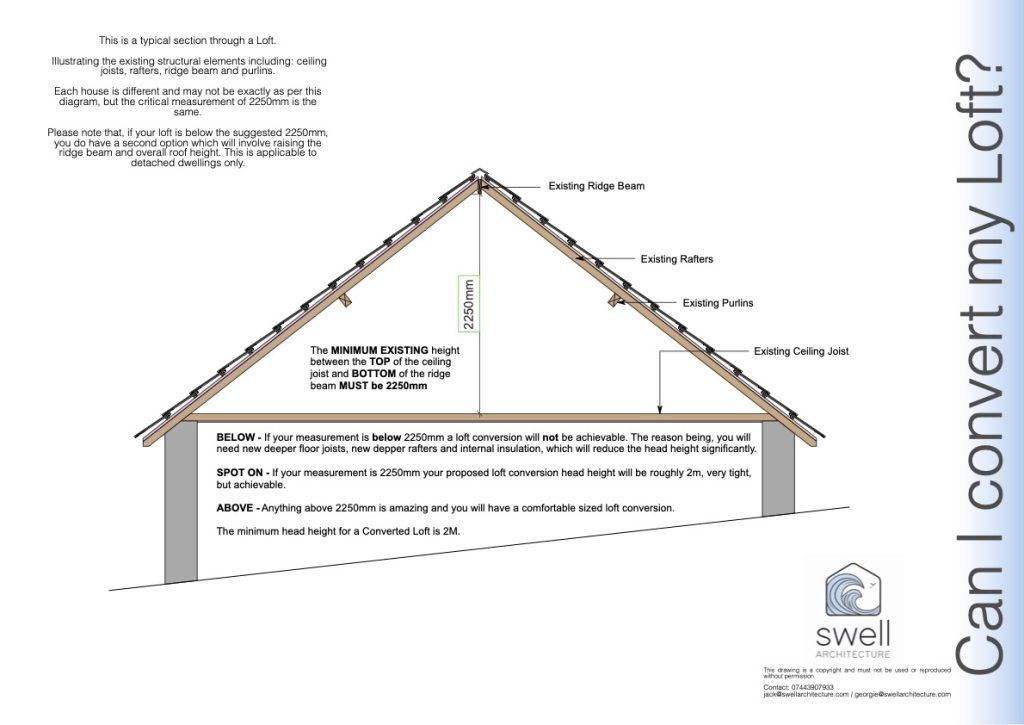How Do I Convert A Loft? A UK Homeowner’s Guide
Are You Dreaming Of Extra Space But Don’t Want To Move? Converting Your Loft Could Be The Perfect Solution! So Ask Yourself, How Can I Convert My Loft?
But before you get carried away with visions of rooftop bedrooms and home cinemas, take a deep breath and consider the practicalities. This guide will walk you through the key factors to determine if your loft conversion dream can become a reality. Once you’ve thought through what you want we will be happy to talk you through your options.
Converting your loft can be an exciting and rewarding project, but it’s important to be realistic and well-informed. By following these steps and seeking professional advice when needed, you can transform your unused attic into a valuable and beautiful addition to your home.
What Do You Want To Convert Your Loft Into?

It might seem to be an obvious question but what do you want to convert your loft into? An ensuite bedroom, a children’s playroom, an office space, extra living space, a guest room, a granny flat, or something else? Each of these options are possible but will require a different design and services. For example an ensuite will require a water supply and drainage services whilst an office space or playroom probably only needs electricity.
In some cases it might make more financial sense to swap rooms around to where the services already exist, and use your loft conversion in another way. The choices are many and yours to decide.
Types of Loft Conversions
There are several types of loft conversion you might consider depending on your loft type and what you want to put in your loft area. Examples include rooflight loft conversions, dormer loft conversions, hip-to-gable conversions, etc. Much will depend on the design of your existing loft space and what you want to use it for.
Assessing Your Loft’s Potential:
Some loft spaces are large open areas with good headroom and are relatively easy to convert. Others are crowded spaces with little headroom but we will use our design and structural engineering expertise to find a cost effective solution.
- Headroom: Is there enough space to stand comfortably? Aim for at least 2.25 metres from the top of the ceiling joists to the underside of the timber ridge beam.
- Floor Area: Can you create a usable room? A minimum of 10 square metres is recommended, though larger is always better.
- Roof Pitch: Steeper pitches offer more usable space and easier conversion. Flat roofs pose more challenges but aren’t impossible.
- Access: Where will the stairs go? Can they fit comfortably within your existing layout?
Overcoming Common Challenges
Some loft conversions are more challenging than others. We’ve seen everything from low headroom, floor joists that need strengthening and damp issues. Solving these challenges is what we are here for. Low headroom can be solved by raising the ridge height, floor joists can be strengthened with new joists bolted to the existing or replaced and damp problems can be solved through replacement tiles, introduction of new membranes or improving ventilation. For us that’s all in a day’s work!
How Long Does It Take and How Much Will It Cost?
Two very tricky questions, as it will likely depend on the size, specification of the loft. Location of the property and your choice of builder will play a part in the time and cost
- Rooflight Loft Conversion – Four Weeks (£10,000 – £25,000)
- Dormer Loft Conversion – Six Weeks (£35,000 – £65,000)
- Hip to gable Loft Conversion – Eight Weeks (£40,000 – £75,000)
Additionally, it is worth noting that a trusted competent builder you should expect to wait from initial appointment any from 3 months up to a year in some cases. This is a typically a good sign that they booked up and trusted to carry out works for other clients.
Using Natural Light In Your Loft Conversion
Good lighting can make a loft conversion and there’s nothing better than natural light?
Large windows are sometimes a possibility but where that’s not possible consider rooflights or sun tunnels as they can make a huge difference in the ambiance of your new space.
Do You Need Storage In Your Loft Conversion?
Who doesn’t love storage space?
Depending on the use you are going to put your loft conversion to, it pays to consider storage space at the outset. Under eaves storage is often a possibility but there are other options, such as clever furniture choices or built in areas that can be designed into your space to ensure you have as much storage space as possible.
Is A Loft Conversion Better Value Than Moving House?
Not only is selling your house and buying another often very stressful, it is also very expensive. Solicitors fees, estate agents commission, removal expenses and mortgage costs are just the start. A move often means painting and decorating: new furniture, carpets and other fittings and all the hassle, such as moving schools, that goes with it.
Set all that expense and hassle against the cost of extending your present home and it makes good economic sense to invest in your present home. That’s why so many people decide to convert their loft into extra usable space.
Environmental, Sustainability and Carbon Neutral Considerations When Converting Your Loft
Building materials not only vary in quality and price, they also vary in sustainable terms.
Whereas wood is natural and absorbs carbon as it grows, steel uses energy in its production. However steel beams are much stronger than wood and are ideal for spanning long spaces without additional supports, whilst timber is natural and looks great. We consider all of this when designing your space and aim for the best use of materials to ensure structural integrity with minimal environmental impact.
Navigating the Planning, Design, Construction and Completion Maze:
Loft conversion projects go through various stages and understanding them before embarking on your loft will save you money and a lot of stress.
Once you’ve decided what you want to build your first step is to engage an architectural technician/architect to draw the plans you’ll need to get planning permission and for your builder to price and build your conversion. Planning may require further input from external parties, i.e. SWW, Arboricultural or Ecology. If your loft conversion requires planing permission typically a ecology (bat/bird) survey will be required to ensure that you are disturbing, harming or obstructing a bat/bird roost.
Once the design of your dreams has been created we can then submit for if required for planning permissions of which more below.
The drawings are also needed by a structural engineer who will ensure that elements such as beam sizes, joists etc are going to be suitable from both a safety and building regulations perspective.
Then it’s over to the builder who will price the work and produce a quote for the building work, giving you a timescale, agree payment terms and ironing out the specifics of your loft conversion.
During the building work a buildings inspector will check on certain aspects of the build to ensure the quality of the work meets the standards laid down in building regulations.
Is Planning Permission Required To Build a Loft Conversion?
It depends! There are a number of ways to ensure your loft conversion is considered permitted development. However and in many cases planning would be required.
- Permitted Development Rights: You may be fortunate for your loft conversion to fall under permitted development rights if:
- All proposed materials and of similar appearance to that of the existing.
- There is no introduction of balconies, raised platforms or verandas.
- The loft conversion does not involved raising of the ridge and overall roof height.
- The volume of the roof is in line with the current allowance for your property type.
Some simple conversions qualify under permitted development, meaning no planning permission is needed, although further regulations do apply. Check your local council’s guidelines, or hire a professional.
- Planning Permission: More complex conversions will require planning permission. Be prepared to submit plans and address any concerns from neighbours or planning authorities.
- Building Regulations: Regardless of planning permission, all conversions must comply with building regulations for safety and structural integrity.
When considering to your loft potential, fire safety is another critical element. There are number of regulations to adhere as part of the building regulations documents. Depending on the type of conversation, generally you will require 30 minutes fire protection which can be achieved through the use of fire rated plasterboard, fitting fire doors and ensuing the is a means of escape i.e through a window.
Cost Considerations:
- Budgeting for the Project: Loft conversions can vary greatly in cost depending on size, complexity, and materials. Get quotes from reputable contractors and factor in unexpected expenses. Hiring trustworthy professionals throughout the process will ensure the risk of unexpected expenses are reduced.
- Adding Value to Your Home: A well-executed loft conversion can significantly increase your property’s value, making it a very worthwhile investment. The added insulation will reduce heat loss and make your home more energy efficient.
Finding the Right Help:
- Architectural Technician/Architect, Structural Engineer, Interior Designer or all of the above?: Complex projects may require expert input to ensure feasibility and structural soundness. We are different at Swell Architecture as we are qualified to both design your loft conversion and maximise functionally and style through interior design. Our background brings a skillset of architecture, technology and interior designs to ensure you get the most of your space.
- Building Contractor: Choose a qualified and experienced contractor with a good track record of loft conversions. Ask to visit examples of their work, we can recommend a number of trusted builders we use.
- Third Parties: Planning may require further input from external parties, i.e. SWW, Arboricultural or Ecology, again we can recommend a number of trusted professionals we use.

If you are considering a loft conversion please contact us for a no fee no obligation chat.





